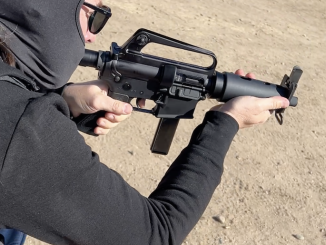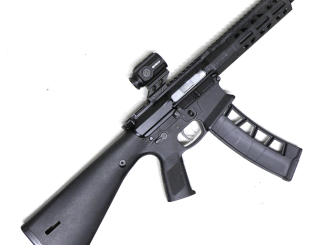Lot 1078 in the September 2020 RIA Premier auction.
This experimental repeating conversion of a Trapdoor Springfield was most likely made by Augustine Sheridan Jones, of the Dakota Territory in the 1880s. We know he submitted a different type of magazine-fed Trapdoor to the US military’s 1882 repeating rifle trials, and this rifle also came out of South Dakota.
At any rate, what the designer did was to, remarkably, figure out a functional way to add a tube magazine to the Trapdoor system. It even has a magazine cutoff feature, allowing it to be run as a single shot rifle with the magazine held in reserve, or as a repeater…




Nice idea, but viable alternatives existed at the time. I don’t want to rehash developments on the private sector, but Winchester laughed at someone for dismissing their rifles as pampered poodle guns. Don’t get me wrong, this rifle shows that someone knew soldiers would hate to deal with a 1-shot-per-10-second fire rate when the other guy is within punching distance. After all, not every foe is content to play stationary clay pigeon half a mile down range. I could be wrong…
The stock may have shattered during testing – or it may have been a steppingstone to Mr Jones’ buttstock magazine, and the eventual owner happily used it until the stock shattered. I recently had a MAS 36 restocked. Someone had added a tang safety, which so weakened the stock it shattered at the wrist.
Hey Ian. Please update the book “Small Arms of the World” by Smith and Ezell. It’s a classic and has not been revised since 1983. Keep up the good work. I really enjoy the work you do.
I have been a fan of the Trap door for many years and also a student of feed systems. This is right up my alley… I had never considered the possibility of a self loading trapdoor. Thanks for the video. I loved it as much as you showed while making the video.
Also, you might want to update “what I’”m currently reading”.
Thanks again for the great video’s. I look forward to them every day.
For the benefit of only modestly increasing the ROF for 8 rounds or so, it would add noticeable fore-end and overall weight.
FW production tip: where snap-caps aren’t an option (which they might be for .45-70), have a bunch of 3D-printer ammo dummies made up, both for function demos, and show&tell for what common and obscure rounds look like.
That is so Kewl!
The Mullins Magazine Rifle, a conversion of the trapdoor to a 30-40 repeater, was entered in the 1892 US trials.
A great thick illustrated history of U.S. Army rifles trials from the Civil War to, say, 1892 (it’s not as much fun after the Krag) would be a major project, but it would sell like ham at Sunday breakfast.
i wonder if the action of it cycling is so violent that it cracked the bottom just operating and maybe that is why it never went any further.
Adding a magazine to a Trapdoor Springfield makes sense, if the conversion costs less than entirely new repeating rifles. The US Army wasn’t well funded after the Civil War. and the state militias usually weren’t any better.
I would not be surprised if some militiamen showed up with 50-year-old muzzle-loaders in 1870.
Very interesting!
By the way, Minot is not pronounced “minnow” like it was French. It’s “MY-not”.
The town is Menno in South Dakota as far as I can tell. It threw me off too.
Note the slot just ahead of the barrel band on the right side of the forend. This Trapdoor would have originally had a spring-tightened barrel band, which was standard on most Springfields from 1861 on. The band in residence is a screw-tightened Enfield-type band, which not only makes more sense on a tubular magazine repeater, it makes more sense, period. See Chapter 25 of Civil War Guns by William B. Edwards for an explanation;
https://archive.org/details/Civil_War_Guns
As for the repetitive Army trials from 1865 to the adoption of the Karg-Jorgenson in 1890-91, they were really only held because Congress wanted them done. By the mid-1880s, notably after the battles around Plevna during the Russo-Turkish Wars of the 1870s, most foreign armies had either adopted repeating rifles or were developing them, and the elected officials thought the U.S. Army should as well.
But for the most part, the Army officers who had been raised on single-shot muzzleloaders and the “primacy of cavalry” were staunchly opposed to the repeater, just as they had fought against the breechloader twenty years earlier. To them, the infantryman was cannon fodder, nothing more, nothing less. Their reaction to a foot soldier having not just a breechloader, but a repeating rifle that could destroy a cavalry charge long before the arme blanche could be brought to bear in the best traditions, was probably about like the reaction of European nobility to the Welsh/English longbow at Crecy and Agincourt.
The cavalry officer was upper class, the infantryman decidedly lower. Anything which made the foot soldier superior to his social “better” was not going to be tolerated, the combat effectiveness of the force be damned.
When the fully-automatic machine gun showed up at the end of the 1880s, the “horsey set” still didn’t realize that as far as their “riding club” was concerned, the repeating rifle was going to be the least of their problems.
They finally figured it out, the hard way, in 1914.
cheers
eon
Ingenious, despite being slightly impractical, function-wise. Ian, you’re correct in that this era of firearms development brought out the creativity! Very cool! Thanks for sharing.